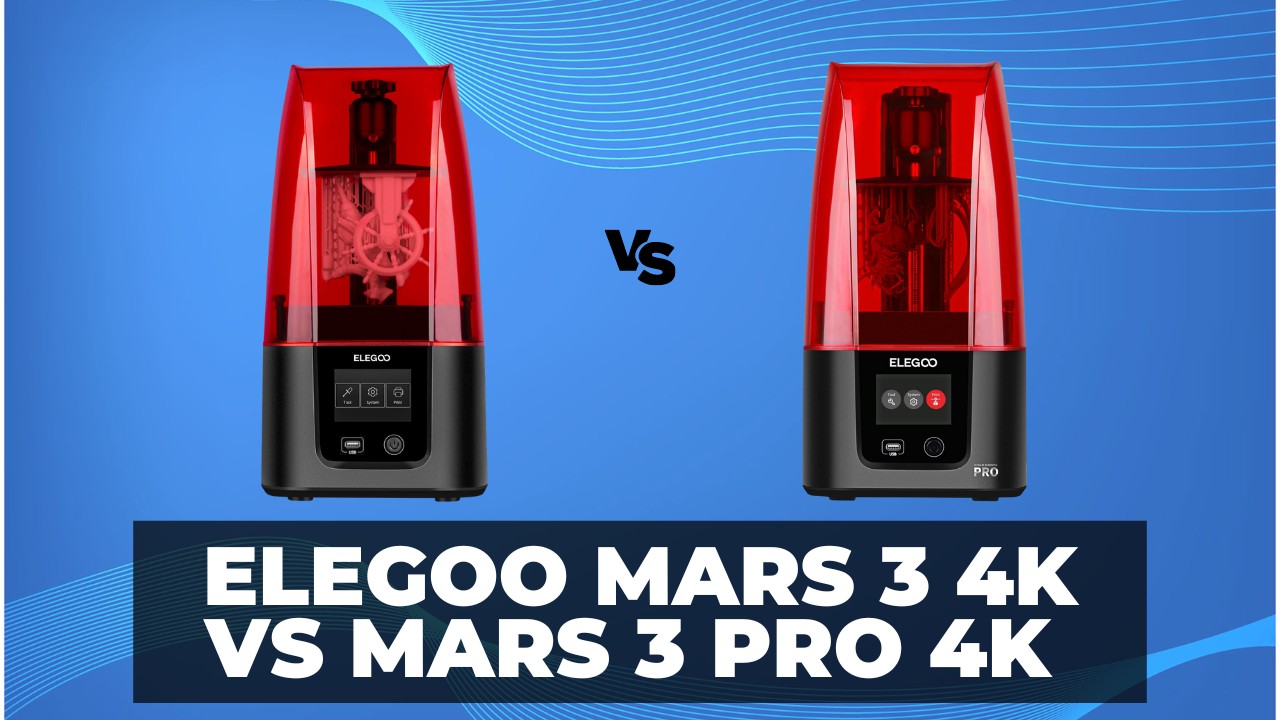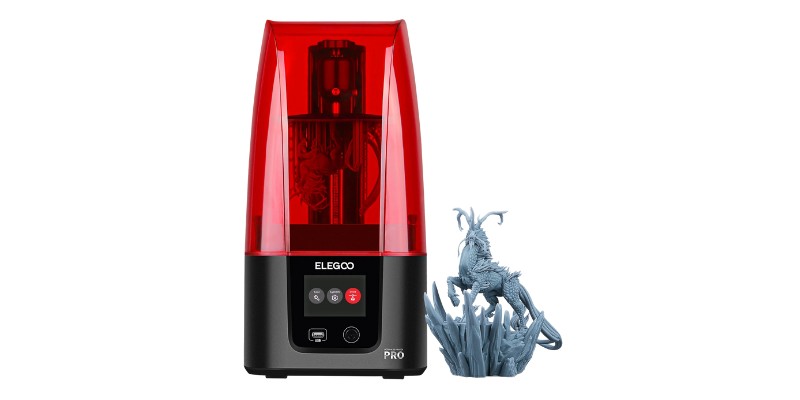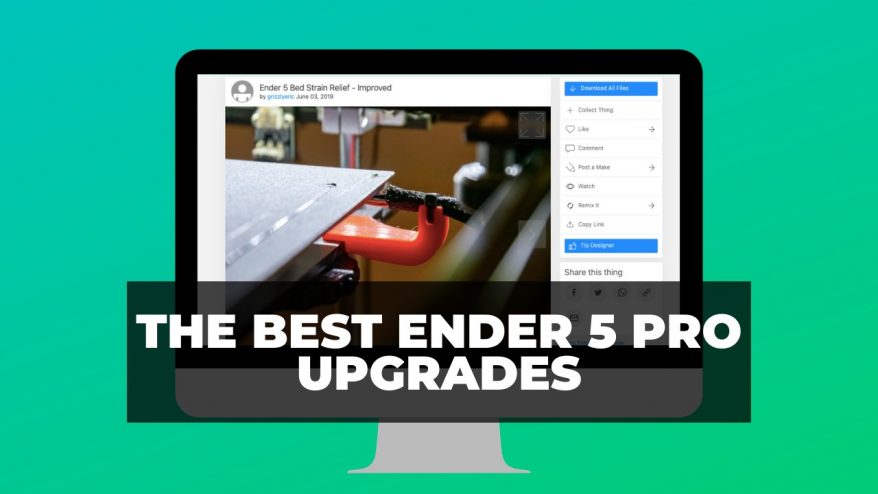
The Elegoo Mars 3 4K and the Mars 3 Pro 4K are obvious options for mid-range resin printers. Upon release, the Mars 3 was an opportunity to get an upgraded version of the Mars 2 without going straight to a member of the Saturn series or another brand entirely.
But once the Mars 3 Pro 4K was available for preorder, things got complicated– how can you know which will suit your needs better? Both variations of the Mars 3 offer many of the same features. Only a few are different.
|
|
|
|
Sturdier Arm:
No
|
Sturdier Arm:
Yes
|
|
Charcoal Air Filter:
No
|
Charcoal Air Filter:
Yes
|
|
Screen Protector Type:
Built-in scratch resistant film
|
Screen Protector Type:
Replaceable tempered glass
|
|
Light Source Tech:
Free-form surface COB lens
|
Light Source Tech:
Free-form surface COB lens, plus Fresnel lens
|
|
$320
|
N/A
|
We’ll cover exactly which specs have changed, what new features you’ll have access to with the pro version, and how those factors will impact your printing projects. Plus, we’ll break down some of the price variables that make the Mars 3 worth it (or not).
Let’s begin.
Elegoo Mars 3 vs Mars 3 Pro: A Quick Summary
Elegoo Mars 3 4K
- Price: Check latest price at ELEGOO here / Amazon here
- Printing technology: MSLA Resin
- Build volume: 143 x 89 x 175 mm
- LCD Size: 6.6’’
- LCD Resolution: 4K +, 4098 x 2560
- XY Resolution: 35 microns
- Max Print Speed: 50 mm/h
- Connectivity: USB

Pros
Won’t give you trouble but will give you great prints.
Well-known for creating high-resolution and highly detailed prints.
Outfitted with a sandblasted build plate and a PFA film that makes it easy to pull your finished prints.
Cons
Small build volume.
Elegoo’s Mars 3 has a perfectly respectable build volume of 143 x 89 x 175 mm. It isn’t as large as the Anycubic Photon M3’s 163 x 102 x 180 mm or the Elegoo Saturn’s 192 x 120 x 200 mm, but that’s exactly why you won’t have to shell out as much money.
The Mars series is well-known for creating high resolution and highly detailed prints, which is part of the reason it’s so popular amongst entry-level and experienced hobbyists alike. Specifically, the Mars 3 has a 4K resolution and an XY resolution of 35 microns.
Even without the pro version, you can print miniatures and similarly detailed projects without issue. Actually, there are few differences (if any) between the detail quality of the Mars 3 and the Mars 3 Pro.
The Mars 3 is outfitted with a sandblasted build plate and a PFA film that makes it easy to pull your finished prints– no desperate scraping required. To top things off, it’s fully compatible with your typical slicers like Lychee, ChiTuBox, and so on.
We have a guide to the best 3D slicers for resin printers, most of which are also compatible with both variations of the Mars 3 4K.
Overall, the Mars 3 won’t give you trouble but will give you great prints. The main downside is the build volume. Still, as long as you know your future doesn’t hold giant statuettes or entire soldier armies to be printed, the Mars 3 is a fine choice.
Elegoo Mars 3 Pro 4K
- Price: Check latest price at ELEGOO here / Amazon here
- Printing technology: MSLA Resin
- Build volume: 143 x 89 x 175 mm
- LCD Size: 6.6’’
- LCD Resolution: 4K +, 4098 x 2560
- XY Resolution: 35 microns
- Max Print Speed: 50 mm/h
- Connectivity: USB

Pros
Many of the same features as Mars 3.
Comes with good quality-of-life features.
Tempered glass protector over the screen, which is an upgrade from the scratch-resistant film of the Mars 3.
Cons
Costs a slight bit extra.
Compared to the other options on the market– like the aforementioned Anycubic Photon M3 and Elegoo Saturn series– the Mars 3 Pro is a happy medium between “great features” and “way too expensive”.
That being said, it shares many of its features with the Mars 3. It has the exact same LCD size of 6.6”, LCD resolution of 4K, and XY resolution of 35 microns. The build volume doesn’t even have a slight increase, either.
What the Mars 3 Pro does have is a higher price for quality-of-life features. Just like the Mars 2 Pro, you’ll have an integrated carbon air filter that’s easy to swap out and makes the whole process much safer.
We’ll talk more about the exact cost breakdown of getting carbon air filters separately and some alternatives for the Mars 3 air filter situation later on. For now, just know that the Mars 3 Pro is more efficient cost-wise once you take into account the other features it has.
There’s also a tempered glass protector over the screen, which is an upgrade from the scratch-resistant film of the Mars 3. Finally, Elegoo added a Fresnel lens to the light source setup. It’s supposedly meant to help spread light more evenly for better prints.
The Similarities

The Mars 3 Pro is characterized just as much by its similarities to the original Mars 3 as it is by its differences. After all, the two printers are largely the same when it comes to specs and raw ability.
In order to know which printer will suit your needs, you’ll have to know exactly what they have in common.
We listed in the basic similarities between the Mars 3 and the Mars 3 Pro below to keep you in the loop about what features are a certainty:
- Build volume of 43 x 89 x 175 mm
- 6.6” LCD Lens
- LCD resolution of 4K + (4098 x 2560)
- XY resolution of 35 microns
- Compatible with slicer software like Lychee and ChiTuBox
- Comes with a ChiTuBox 1 year subscription for free
- Sandblasted build plate
- Free-form surface COB lens
- Some type of screen protector
- Touch screen and USB port in the front of the printer
- Max print speed of 50 mm/h
The Differences
Since the differences between the Mars 3 and the Mars 3 Pro 4K are few in number, let’s start out by looking at a basic summary table before going deeper:
Arm Design
It’s not often mentioned in comparisons of the two printers, but the arm on the Mars 3 Pro printer is actually upgraded to be sturdier. The older Mars 3’s arm might shake on occasion since it’s flimsier.
All things considered, this is just a small upgrade that makes the Pro feel more professional. It has little impact on the print quality.
Air Filtration
The main advertised difference that you’ll see between the Mars 3 and the Mars 3 Pro 4K is the inclusion of a carbon air filter in the Pro version.
The fumes that are released while printing resin are a major concern for some hobbyists, since they’re toxic and can cause health issues down the line. Plus, the smell is just plain bothersome to many people.
Unlike the Mars 2 Pro that had a completely built-in air filter, the Mars 3 Pro has a USB slot inside the printer where you can attach a filter. This format makes it much easier to change out the activated carbon, or even the entire filter if need be.
You’ll get one Mars filter with a USB connection when you order the Mars 3 Pro. Alternatively, you can purchase extra ELEGOO filters on Amazon or elsewhere once it stops working.

Interestingly, you can get a variation of the carbon filter that can be used without directly plugging into the printer itself. They were originally designed for the Mini 2 and are thus very small filters, but they’re functional no matter where you use them.
That means you can give the Mars 3 a filtration system, just like the Mars 3 Pro. You’ll spend $30 on a pack of two of these standalone ELEGOO carbon filters– AKA, $15 a pop for a similar upgrade as the Mars 3 Pro gives you.
The only downsides of the standalone filters are that they’re smaller (and might not have as much of an impact on larger printers) and that they run on a battery charge.
Since you can’t plug them directly into a Mars 3, you’re limited in how long your filter will work. The maximum battery charge is 24h.
Don’t get us wrong: the Mars 3 Pro is still an improvement over the Mars 3 when it comes to filtration. But you can definitely find ways to get similar results without purchasing the Pro version.
With Activated Carbon Filter and Universal Adaptor for LCD/DLP/MSLA Resin 3D Printers
Screen Protector
Whether or not you believe in needing screen protection, mistakes do happen. It’s worth considering the Mars 3 Pro’s tempered glass screen protector as a serious upgrade. If you damage the LCD on either printer, it’ll run you at least $50 to replace it.
The Mars 3 does have a screen protector, but it’s far less potent. It’s just a scratch resistant film to prevent small slip-ups and won’t help you if you make any larger type of mistake.
For example, it’s easy to forget to clean off the build plate after failed prints and allow buildup, especially if you’re new to resin printing. This can eventually damage the LCD permanently if the buildup becomes too severe.
The Mars 3’s screen protector should protect you from small spills or scratches that happen while doing vat changes or cleaning. It won’t be a reliable safeguard against larger spills or accidents.
Ultimately, it’s up to you whether you feel like the extra safety is worth the extra price.
HD Resolution: 4098 x 2560,
Replaceable Anti-Scratch Tempered Glass,
Compatible with Mars 3 Pro LCD Resin 3D Printer
Light Source Tech
Both printers use free-form surface COB lenses as their main light source for curing. An eternal struggle with resin printers, though, is trying to get that light to spread uniformly.
Any uneven distribution of UV light is particularly noticeable on flat surfaces in prints, where you might see striping or other oddities.
The Mars 3 Pro has the addition of a Fresnel lens, which is meant to help disperse the UV light evenly. It’s difficult to measure the improvement in print quality, since there are so many factors involved.
Still, it’s safe to say that the Fresnel lens will at least minimize the chance of UV light dispersion issues occurring. These problems are always fixable, but the lens is a nice addition regardless.
Price
- ELEGOO Mars 3 Ultra 4K – $320
- ELEGOO Mars 3 Pro Ultra 4K – $350
After going over the differences, it makes sense that the official price difference is only $30. Unfortunately, it can be difficult to find the Mars 3 for that price, since it’s often out of stock. The price difference can be as much as $100 without sales.
In order to help you decide whether the price you’re getting at this moment is going to be worthwhile, we broke down some of the costs of upgrading the original Mars 3 to be like the Mars 3 Pro:
- A tempered glass screen protector can range between $15 – $25, but you might need to get it custom cut to fit the dimensions of the Mars 3
- Standalone air filters can range between $15 – $30, depending on brand and size
- Fresnel lenses in the right size are unrealistic to find and install in a Mars 3
If the Mars 3 Pro will cost you more than $55 more than the Mars 3, at whatever point you’re purchasing it, then it might not be worthwhile. But regardless of the dollar price, you should also consider how much you value the upgrades to begin with and how much you value the time it will take you to research and install them by hand.
|
|
|
|
Sturdier Arm:
No
|
Sturdier Arm:
Yes
|
|
Charcoal Air Filter:
No
|
Charcoal Air Filter:
Yes
|
|
Screen Protector Type:
Built-in scratch resistant film
|
Screen Protector Type:
Replaceable tempered glass
|
|
Light Source Tech:
Free-form surface COB lens
|
Light Source Tech:
Free-form surface COB lens, plus Fresnel lens
|
|
$320
|
N/A
|
Elegoo Mars 3 4K vs Mars 3 Pro 4K– The Bottom Line
It’s time to get our heads out of the weedy details: fundamentally, the Mars 3 can print everything that the Mars 3 Pro can. The projects you’re able to take on are going to be exactly the same, regardless of which printer you buy.
With that out of the way, there are valid reasons to opt for the Pro version. You’ll likely be happier with just purchasing the Mars 3 Pro if you plan on using filters regularly, and the bonus safety of the glass screen protector is another plus.
But that’s really the only context in which the Mars 3 Pro is better than the Mars 3. For most hobbyists, the Mars 3 is functional enough to make it difficult to excuse the Pro’s higher price.
Related articles:
- Elegoo vs Anycubic: Mars (3 & 2 Pro) vs Photon Mono 4K
- Elegoo Jupiter vs Phrozen Sonic Mega 8K / Mighty 8K
- Elegoo Mars 3 / 3 Pro vs Anycubic Photon M3
- Which Is The Best Between The Elegoo Saturn vs Elegoo Mars (2 Pro / 3)
- Anycubic Photon M3 Max vs Elegoo Jupiter (& Saturn 2)
- Elegoo Neptune 3 Pro vs 3 vs 2S vs 2 vs 2D vs X
- Elegoo Saturn vs Saturn S vs Saturn 2
- Anycubic vs Elegoo: Which Of Their Resin Printers Is Best For You?
- Complete Buyer’s Guide: The Best Elegoo 3D Printers
- [REVIEW] Elegoo Mars 2 Pro: A Low-Cost, High Quality Resin Printer
- Which Are The Best Online Shops to Buy a 3D Printer + Tips
- The Most Popular Resin 3D Slicers Out Now (SLA/DLP/LCD)








